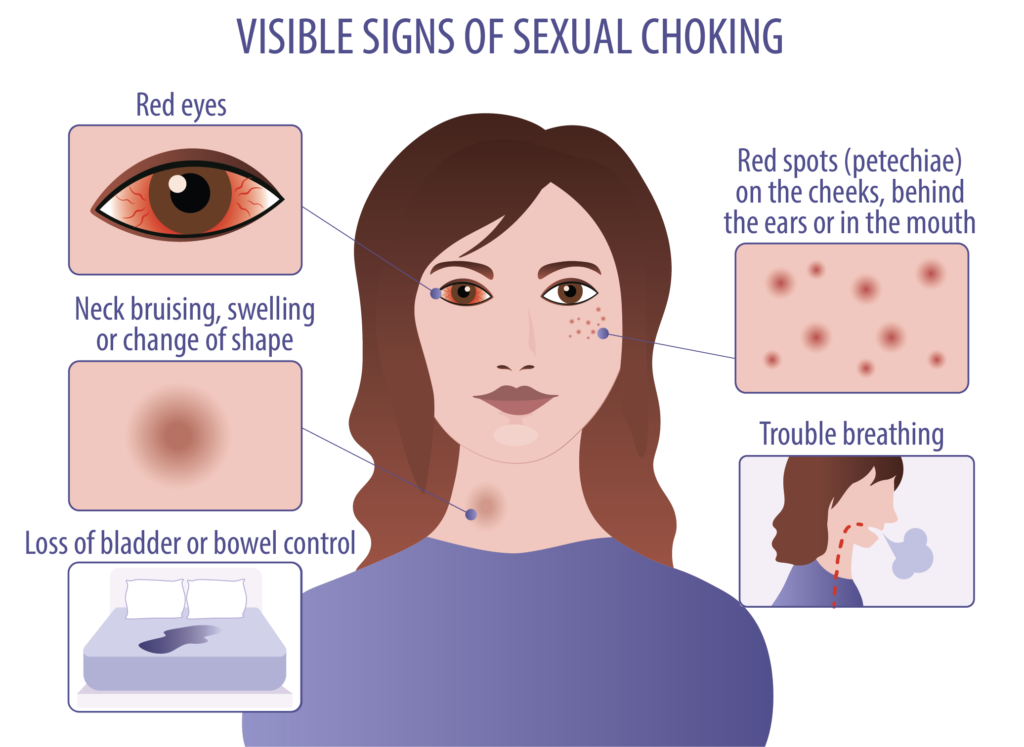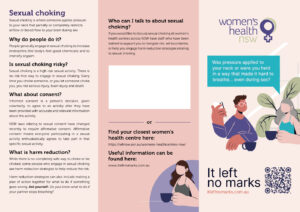Sexual choking is where someone applies pressure to your neck that partially or completely restricts airflow or blood flow to your brain during sex. It can also be called breath play or erotic asphyxiation.
Why do people do it?
People generally engage in sexual choking to increase endorphins (the body’s feel-good chemicals) and to intensify orgasm. Sexual choking might also be part of edge play (a buzz you get from doing risky things and surviving them), bondage and discipline (BDSM and power play), rough sex, or sometimes just because people are curious.
Is sexual choking risky?
Sexual choking is a high-risk sexual activity. There is no risk-free way to engage in sexual choking. Every time you choke someone, or you let someone choke you, you risk serious injury, brain injury and death. There can also be legal consequences, even if the activity was done with consent. People may argue whether there was consent or not, especially if they have suffered injury. Alongside the risk of criminal charges, there is also a risk of civil legal claims, particularly if the person being choked suffers long-term impacts like a brain injury.
What about consent?
Informed consent is a person’s decision, given voluntarily, to agree to an activity after they have been provided with accurate and relevant information about the activity. All of us have experience with giving informed consent for medical procedures. We should strive for the same sort of informed consent with high-risk sexual activities.
NSW laws relating to sexual consent have changed recently to require affirmative consent. Affirmative consent means everyone participating in a sexual activity enthusiastically agrees to take part in that specific sexual activity. There are some resources below explaining what NSW law requires of you to achieve affirmative consent.
How can I lower the risk of harm?
While there is no completely safe way to choke or be choked, some people who engage in sexual choking use harm reduction strategies to help reduce the risk.
If we think about different ways to sexually choke someone as sitting on a scale from highest risk to lowest risk, tying something around your own or someone else’s neck that can’t be instantly released; choking to the point where someone loses consciousness; choking or being choked under the influence of drugs or alcohol; and choking someone who is already recovering from a brain injury, or who has existing heart or breathing problems like asthma, might all sit in the highest risk category. Ask yourself: Do you know the medical history of someone you’re intending to sexually choke?
Down at the safer end of the sexual choking risk scale are activities like holding your own breath (so you can let it go when it gets scary) and simulating choking (play acting) rather than actually restricting someone’s air or blood flow. Simulation allows you to explore this sexual fantasy without as many risks to health and safety. It still isn’t risk-free: even simulated sexual choking can trigger someone’s memories of violence. Ask yourself: Do you know what to do if your sexual partner starts to have a panic attack?
Harm reduction strategies can also include making a plan of action together before you try sexual choking, so you both know what to do if something goes wrong. Ask yourself: Do you know what to do if your partner stops breathing?
How often is it safe to sexually choke someone?
There are two main risks with choking that we need to be careful about: damage to the neck, and damage to the brain. When you are choked the blood vessels in your neck and your airway can be damaged or can be narrowed due to swelling of the skin and soft tissues in the neck. This swelling is at its greatest about 2 days after you choke, and then slowly reduces, so we recommend that you wait at least 4 days between choking.
Each time you are choked, there is a period of time when the oxygen supply to your brain is cut off or reduced. Every time this happens there may be damage to brain cells, and this damage can build up over time, and lead to significant problems with your brain function. This is why we do not recommend that choking becomes part of your “daily” or regular sexual practice but instead is something that you only practice occasionally.
When should I seek medical attention?
If the person being choked stops breathing, loses consciousness, has a seizure, or seems confused, disorientated or agitated, you should call 000. Most sexual choking will stop short of producing any visible signs. If you do see any of the visible signs indicated below, you should strongly consider seeking medical attention as they may mean you have a more serious injury.

Listen to your body: Book a GP appointment or head straight to emergency if any neurological symptoms like headaches, visual disturbances, dizziness, ringing in ears, memory loss, or light sensitivity don’t resolve shortly after engaging in sexual choking.
Who can I talk to about sexual choking?
If you would like to discuss sexual choking, women’s health centres across NSW have some staff who have been trained to support you to navigate risk, set boundaries, or help you engage harm reduction strategies relating to sexual choking. Find your closest women’s health centre here: https://whnsw.asn.au/womens-health-centres-nsw/
It Left No Marks brochure for women
 This printable brochure contains information on sexual choking on one side, and strangulation on the other side. It’s a handy resource to keep on hand if you engage in sexual choking as the tips for managing an injury at home apply in both situations: https://www.itleftnomarks.com.au/resources/it-left-no-marks-brochure-for-women/
This printable brochure contains information on sexual choking on one side, and strangulation on the other side. It’s a handy resource to keep on hand if you engage in sexual choking as the tips for managing an injury at home apply in both situations: https://www.itleftnomarks.com.au/resources/it-left-no-marks-brochure-for-women/
We are also in the process of making some extra resources to help. In the meantime, we have collected some things you can watch, listen to, or read.
Things to watch, listen to, or read
READ: Choking during sex: many young people mistakenly believe it can be done safely, our study shows
https://theconversation.com/choking-during-sex-many-young-people-mistakenly-believe-it-can-be-done-safely-our-study-shows-248867
READ: ‘I think it’s natural’: why has sexual choking become so prevalent among young people? https://www.theguardian.com/lifeandstyle/article/2024/sep/02/i-think-its-natural-why-has-sexual-choking-become-so-prevalent-among-young-people
READ: Minimising the risk: Teen perspectives on sexual choking in pornography https://journal.media-culture.org.au/index.php/mcjournal/article/view/3088
LISTEN: Breathless—Navigating the risks and realities of erotic strangulation https://open.spotify.com/episode/5Ke9RGjosHvjHUqf6brKhD?si=jTn6VGeAQaSa7AuW1twQ8g1qq&nd=1&dlsi=14cf23c6aa35427a
READ: Breathe: Risks, realities, and safer alternatives to choking and breath play https://www.scarleteen.com/read/sex-sexuality/breathe-risks-realities-safer-choking-breath-play
READ: More than half of Australian young people are using strangulation during sex: new research https://theconversation.com/more-than-half-of-australian-young-people-are-using-strangulation-during-sex-new-research-231269
READ: Choking during sex: many young people mistakenly believe it can be done safely, our study shows https://theconversation.com/choking-during-sex-many-young-people-mistakenly-believe-it-can-be-done-safely-our-study-shows-248867
READ: Explainer: the reform of sexual consent laws in NSW https://www.unsw.edu.au/newsroom/news/2022/06/explainer-reform-sexual-consent-laws-nsw
READ: Sexual consent: Consent laws in NSW https://dcj.nsw.gov.au/children-and-families/family-domestic-and-sexual-violence/sexual-violence/sexual-consent.html
LISTEN: Hold your breath–why some people turn to choking during sex https://podcasts.apple.com/au/podcast/hold-your-breath-why-some-people-turn-to-choking-during-sex/id1555134064?i=1000621131409
READ: Everything you need to know about erotic asphyxiation https://www.healthline.com/health/healthy-sex/erotic-asphyxiation
WATCH: What actually happens when someone is choked https://www.intheknow.co.nz/choking/listen/
WATCH: Sexplanations: Erotic choking https://www.youtube.com/watch?v=DPlrum6p4xg